 |
 |
Our enthusiastic and extremely knowledgeable perennials team is here to answer your questions and help you choose the best perennials for your situation. There’s always something in bloom for sun, shade, butterflies, birds or deer resistance as well as a variety of bulbs for your space.
Stroll through our time-tested favorites and introduce yourself to the newest varieties. We garden with perennials too; we love them and it shows!
|
30 found, showing page 2 of 2

Heat and humidity tolerant, mounding habit, and periwinkle blue blooms appearing late spring. Near-Black Stems. USDA 4-9
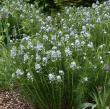
Long-lived plant with clusters of blue flowers in May and June and golden fall color on an upright, bushy plant. USDA 5-8
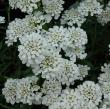
White flowers & dark semi-evergreen leaves offer dense contrasting color. USDA 3-8
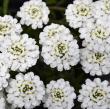
White blooms. Uniform mounding evergreen groundcover. USDA 4-8
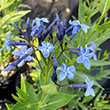
Native clump-forming slow speading groundcover. Blue spring flowers, feathery green summer foliage, and golden fall color. USDA 5-9
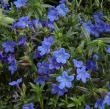
Bright purpley blue blooms. Deep green foliage. Groundcover. USDA 6-8
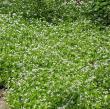
White blooms. Fragrant lance-shaped dark green leaves. Edible foliage. Tolerates deep shade. USDA 4-8
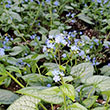
Blue-pink blooms. Silver & green Foliage. Increased sun tolerance. USDA 3-9
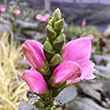
Uniquely shaped, hot pink blooms atop dark green leaves with a bronzy sheen.Best of moist or wet shade. Showy and long lived. USDA 4-9
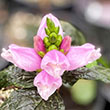
Height: 3 feet
Spread: 3 feet
Sunlight: full sun partial shade
Hardiness Zone: 4a
Other Names: Lyon's Turtlehead, Shellflower
Description:
Lush deep-green, shiny leaves topped with hot rosey-pink flowers which are shaped like little turtle heads; tolerant to moisture, this spreading plant is fantastic for stream edges and in bog gardens
Ornamental Features:
Hot Lips Turtlehead has masses of beautiful hot pink hooded flowers at the ends of the stems from late summer to mid fall, which are most effective when planted in groupings. The flowers are excellent for cutting. Its glossy pointy leaves remain dark green in color throughout the season.
Landscape Attributes:
Hot Lips Turtlehead is a dense herbaceous perennial with an upright spreading habit of growth. Its medium texture blends into the garden, but can always be balanced by a couple of finer or coarser plants for an effective composition.
This plant will require occasional maintenance and upkeep, and is best cleaned up in early spring before it resumes active growth for the season. Gardeners should be aware of the following characteristic(s) that may warrant special consideration: Spreading
Hot Lips Turtlehead is recommended for the following landscape applications:
- Mass Planting
- General Garden Use
- Naturalizing And Woodland Gardens
- Bog Gardens
Planting & Growing:
Hot Lips Turtlehead will grow to be about 3 feet tall at maturity, with a spread of 3 feet. Its foliage tends to remain dense right to the ground, not requiring facer plants in front. It grows at a medium rate, and under ideal conditions can be expected to live for approximately 12 years. As an herbaceous perennial, this plant will usually die back to the crown each winter, and will regrow from the base each spring. Be careful not to disturb the crown in late winter when it may not be readily seen!
This plant does best in full sun to partial shade. It prefers to grow in moist to wet soil, and will even tolerate some standing water. It is not particular as to soil pH, but grows best in rich soils. It is somewhat tolerant of urban pollution. Consider applying a thick mulch around the root zone over the growing season to conserve soil moisture. This is a selection of a native North American species. It can be propagated by division; however, as a cultivated variety, be aware that it may be subject to certain restrictions or prohibitions on propagation.

Mound of large, heart-shaped, silvered leaves. Sprays of blue forget-me-not flowera. Makes a dynamic statement in the woodland garden.. USDA 3-8
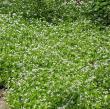
White blooms. Fragrant lance-shaped dark green leaves. Edible foliage. Tolerates deep shade. USDA 4-8
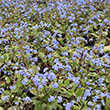
Distinctive silvery white leaves with a thin green rim around the leaf edges. Small, forget-me-not-like flowers of light blue with yellow centers. USDA 2-8
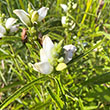
Height: 3 feet
Spread: 30 inches
Sunlight: full sun partial shade
Hardiness Zone: 3a
Other Names: Shellflower
Description:
The white hooded flowers on this perennial make it a great addition to the garden; thrives in wet or moist areas; attracts butterflies
Ornamental Features:
Turtlehead has masses of beautiful white hooded flowers with shell pink overtones at the ends of the stems from late summer to mid fall, which are most effective when planted in groupings. The flowers are excellent for cutting. Its serrated pointy leaves remain dark green in color throughout the season.
Landscape Attributes:
Turtlehead is a dense herbaceous perennial with an upright spreading habit of growth. Its medium texture blends into the garden, but can always be balanced by a couple of finer or coarser plants for an effective composition.
This plant will require occasional maintenance and upkeep, and is best cleaned up in early spring before it resumes active growth for the season. Gardeners should be aware of the following characteristic(s) that may warrant special consideration: Spreading
Turtlehead is recommended for the following landscape applications:
- Mass Planting
- General Garden Use
- Naturalizing And Woodland Gardens
- Bog Gardens
Planting & Growing:
Turtlehead will grow to be about 3 feet tall at maturity, with a spread of 30 inches. Its foliage tends to remain dense right to the ground, not requiring facer plants in front. It grows at a medium rate, and under ideal conditions can be expected to live for approximately 12 years. As an herbaceous perennial, this plant will usually die back to the crown each winter, and will regrow from the base each spring. Be careful not to disturb the crown in late winter when it may not be readily seen!
This plant does best in full sun to partial shade. It is quite adaptable, prefering to grow in average to wet conditions, and will even tolerate some standing water. It is not particular as to soil pH, but grows best in rich soils. It is somewhat tolerant of urban pollution. Consider applying a thick mulch around the root zone over the growing season to conserve soil moisture. This species is native to parts of North America. It can be propagated by division.
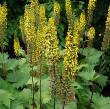
Huge lemon-yellow flower spikes. Deep purple stems. Large green, toothed foliage. USDA 4-8
30 found, showing page 2 of 2








